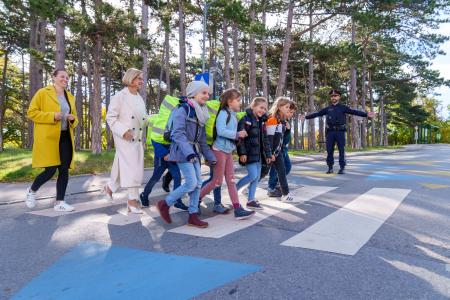Our members are dedicated to improving road safety and sharing their knowledge with the wider community. Here, you can explore our members' good practices – initiatives that have been assessed for their effectiveness in addressing a road safety problem and have proven results.
Get inspired – and sign up to share your good practices too!

Friday, July 14, 2023
Slovenia is a country with a lot of small and very dispersed settlements where public transport does not cover the needs of mobility. 2 million inhabitants have as many as 1.2 million cars. The proportion of older drivers (61+) is 28% and is growing. For elderly, the car is a source of autonomy, mobility and a building block of social inclusion. Drivers in this age group are the most common drivers of fatal accidents, most often in which they die themselves. During their driving career, cars, infrastructure, road rules, driving dynamics have changed and new forms of mobility have developed.

Friday, June 2, 2023
Il settore del delivery e' quello che maggiormente necessità di regolamentazione della sicurezza su strada.
Il modello utilizzato e operato dai bigplayers (ancora in Italia) è quello che i riders sono considerati lavoratori autonomi, con scarse tutele, un lavoro accessibile per tutti, in cui basta avere un mezzo e un cellulare. Criteri che noi consideriamo completamente insufficenti per operare in sicurezza e garanzia di servizio. Due to, questo modello di competizione imposto dai delivery players (più consegni = più guadagni) spinge il rider a consegnare senza nozioni o criteri di sicurezza stradale, in molti casi, elaborati e modificati in maniera fuori legge ai fini di aumentarli la velocità. Perché in questo sistema più corri, più consegni e più guadagni. Infatti, si registra un numero crescente di incidenti e morti tra i riders.
Il delivery per le sue caratteristiche, esclude un genere nello specifico, le donne, che non trovandolo sicuro e garantito non pensano di trovarvi occupazione, nonostante questo sia un settore in crescita e possa rappresentare tante opportunità di lavoro se viene esercitata corretamente,
Ed è per questo motivo che il nostro progetto è nato.
Per creare un modello di occupazione, inclusione e sicurezza.
TAKEVE, startup, società benefit è l’unico modello di delivery al femminile che impiega le donne disoccupate, precarie e in difficoltà sociale, assumendole regolarmente ha cercato da subito di contribuire a risolvere questo problema, riconosciuto dal Presidente della Repubblica Italiana, Sergio Mattarella, dal Senato, Camera di Commercio e istituzioni varie.
Altri problemi riscontrati dal delivery in termini di sicurezza stradale, non riguardano solo i riders, ma anche i cittadini che subiscono il loro traffico sregolato e i piccoli commercianti, penalizzati nel last mile, da un servizio non garantito e sicuro.
L’ambito del delivery proprio per la sua accessibilità consente a tutti di diventarne operatori, e più del 70 % sono immigranti, che entrano in situazione di svantaggio e vulnerabilità. Molti di loro, senza conoscere la lingua, formazione efficace per svolgere il lavoro, segnaletica e normative stradale, e altri aspetti di inserimento culturale e riferimenti sociali.
L'obiettivo di TAKEVE da subito è stato quello di stato creare modello etico, con un nuovo concetto di formazione, facile e coinvolgente, che creasse reali opportunità di lavoro basate su regole, sicurezza, permettendo il riconoscimento ufficiale di questa professionalità, sempre più richiesta da un settore fortemente in crescita.
Una formazione innovativa, con la fornitura di Dpi Luxon (gilet catarifrangente con tecnologia NFT di tracciamento di dati anagrafici, assicurativa e sanitaria), abbigliamento antinfortunistica,un control center diretto con app sos rider, strumenti e mezzi elettrici road safety e soprattutto un modello che non devono competere per guadagnare di più, ma consegnare in serenità e garanzia, evitando i rischi stradali.
Per questo abbiamo individuato partners che ci supportassero con i migliori strumenti, al fine di rendere scalabile, replicabile in tutto il mondo, un modello di delivery restaurato e riqualificato per garantire sicurezza stradale ed efficienza anche al b2c che il b2b riders formati nella professione, in maniera effettiva e verificata e non solo superficialmente come accade ora per tutti i grossi players del mercato.
Il modello utilizzato e operato dai bigplayers (ancora in Italia) è quello che i riders sono considerati lavoratori autonomi, con scarse tutele, un lavoro accessibile per tutti, in cui basta avere un mezzo e un cellulare. Criteri che noi consideriamo completamente insufficenti per operare in sicurezza e garanzia di servizio. Due to, questo modello di competizione imposto dai delivery players (più consegni = più guadagni) spinge il rider a consegnare senza nozioni o criteri di sicurezza stradale, in molti casi, elaborati e modificati in maniera fuori legge ai fini di aumentarli la velocità. Perché in questo sistema più corri, più consegni e più guadagni. Infatti, si registra un numero crescente di incidenti e morti tra i riders.
Il delivery per le sue caratteristiche, esclude un genere nello specifico, le donne, che non trovandolo sicuro e garantito non pensano di trovarvi occupazione, nonostante questo sia un settore in crescita e possa rappresentare tante opportunità di lavoro se viene esercitata corretamente,
Ed è per questo motivo che il nostro progetto è nato.
Per creare un modello di occupazione, inclusione e sicurezza.
TAKEVE, startup, società benefit è l’unico modello di delivery al femminile che impiega le donne disoccupate, precarie e in difficoltà sociale, assumendole regolarmente ha cercato da subito di contribuire a risolvere questo problema, riconosciuto dal Presidente della Repubblica Italiana, Sergio Mattarella, dal Senato, Camera di Commercio e istituzioni varie.
Altri problemi riscontrati dal delivery in termini di sicurezza stradale, non riguardano solo i riders, ma anche i cittadini che subiscono il loro traffico sregolato e i piccoli commercianti, penalizzati nel last mile, da un servizio non garantito e sicuro.
L’ambito del delivery proprio per la sua accessibilità consente a tutti di diventarne operatori, e più del 70 % sono immigranti, che entrano in situazione di svantaggio e vulnerabilità. Molti di loro, senza conoscere la lingua, formazione efficace per svolgere il lavoro, segnaletica e normative stradale, e altri aspetti di inserimento culturale e riferimenti sociali.
L'obiettivo di TAKEVE da subito è stato quello di stato creare modello etico, con un nuovo concetto di formazione, facile e coinvolgente, che creasse reali opportunità di lavoro basate su regole, sicurezza, permettendo il riconoscimento ufficiale di questa professionalità, sempre più richiesta da un settore fortemente in crescita.
Una formazione innovativa, con la fornitura di Dpi Luxon (gilet catarifrangente con tecnologia NFT di tracciamento di dati anagrafici, assicurativa e sanitaria), abbigliamento antinfortunistica,un control center diretto con app sos rider, strumenti e mezzi elettrici road safety e soprattutto un modello che non devono competere per guadagnare di più, ma consegnare in serenità e garanzia, evitando i rischi stradali.
Per questo abbiamo individuato partners che ci supportassero con i migliori strumenti, al fine di rendere scalabile, replicabile in tutto il mondo, un modello di delivery restaurato e riqualificato per garantire sicurezza stradale ed efficienza anche al b2c che il b2b riders formati nella professione, in maniera effettiva e verificata e non solo superficialmente come accade ora per tutti i grossi players del mercato.

Friday, June 2, 2023
To ensure both driver and vehicle are fit and safe before departing on the road from a remote operations perspective, a journey management mobile app was created where the driver takes the ownership of the trip.

Friday, June 2, 2023
The campaign addresses potentially dangerous situations in road traffic that often arise due to distractions or speeding. In particular, lack of concentration, for example, due to handling a mobile phone while being on the move, poses a great risk. Increased consideration and mindfulness not only contribute to the safety of everyone but also ensure that all road users, including the slower and weaker ones, can feel comfortable in traffic.

Friday, June 2, 2023
The Netherlands is a country of cycling. There, the bike is an important means of transportation and elderly people are no exception to this. Cycling helps to keep people fit and included in their communities, but elderly people are unfortunately among the most at risk on a bike. The number of elderly cyclists injured in accidents has increased dramatically in the past 25 years.
The number of cycling victims with serious injuries has risen sharply in the past 10 years (40% in the period 2013-2022).
For example, the most recent figures show that in 2022, 88,800 cyclists will end up in the emergency department in the Netherlands. Of these, 57,000 cycling victims had serious injuries (VeiligheidNL). It is expected that the number of serious road injuries among cyclists in unilateral crashes will increase by 80% over the period 2018-2040. The over-65s are regarded as an important risk target group. The group aged 65 and over is growing, the share of the over 80s is growing, they are both becoming more mobile and more opting for the bicycle as a means of transport (SWOV)
Therefore, under the motto “do not get off, but keep on pedalling”, CycleOn aims to ensure that elderly people are included in the Dutch cycle network, by motivating them to continue enjoying the health and pleasure benefits of cycling while focusing on safety.
Road safety was the main motivation for initiating the project, with a focus on behavioural change rather than infrastructure. This initial emphasis on road safety quickly transformed into a broader project of promoting cycling among the elderly for the benefit of their health, happiness and social inclusion.
The number of cycling victims with serious injuries has risen sharply in the past 10 years (40% in the period 2013-2022).
For example, the most recent figures show that in 2022, 88,800 cyclists will end up in the emergency department in the Netherlands. Of these, 57,000 cycling victims had serious injuries (VeiligheidNL). It is expected that the number of serious road injuries among cyclists in unilateral crashes will increase by 80% over the period 2018-2040. The over-65s are regarded as an important risk target group. The group aged 65 and over is growing, the share of the over 80s is growing, they are both becoming more mobile and more opting for the bicycle as a means of transport (SWOV)
Therefore, under the motto “do not get off, but keep on pedalling”, CycleOn aims to ensure that elderly people are included in the Dutch cycle network, by motivating them to continue enjoying the health and pleasure benefits of cycling while focusing on safety.
Road safety was the main motivation for initiating the project, with a focus on behavioural change rather than infrastructure. This initial emphasis on road safety quickly transformed into a broader project of promoting cycling among the elderly for the benefit of their health, happiness and social inclusion.